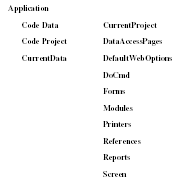E.1. The Application Object
All of the Access objects you'll manipulate within code are derived from the Application object. This is the parent object for all other objects and collections within the Access object model. All objects and collections are related to the Application object, either through a direct parent/child relationship or through multiple parent/child relationships. Figure E-1 lists the objects and collections that are the direct children of the Application object.
The Application object refers to the currently active Access application. This object contains all Microsoft Access objects and collections. You can use the Application object to apply methods or set properties for the entire Access application. For example, you can use the SetOptions method of the Application object to control just about all the settings visible on the Tools | Options dialog box. The various settings you can use with the SetOptions method are listed a little later in this appendix. The following code displays hidden objects in the database window.
Figure E.1. Figure E-1

Application.SetOption "Show Hidden Objects", True
Just about all code you write within Access utilizes the Application object somewhere within the code.
E.1.1. Properties of the Application Object
The following table lists the various properties of the Application object. Please note that this table contains not only ...
Get Access 2003 VBA Programmer's Reference now with the O’Reilly learning platform.
O’Reilly members experience books, live events, courses curated by job role, and more from O’Reilly and nearly 200 top publishers.

